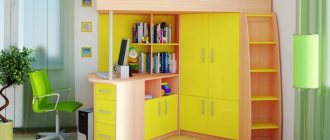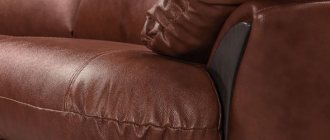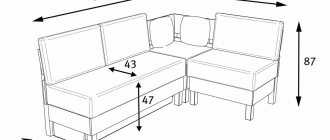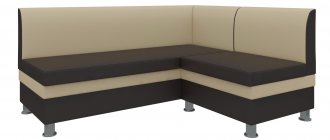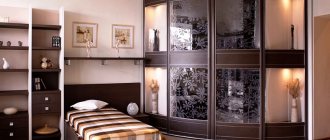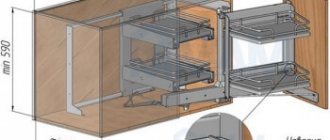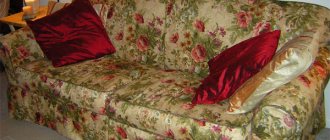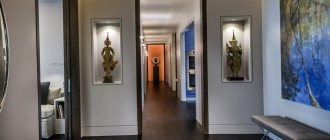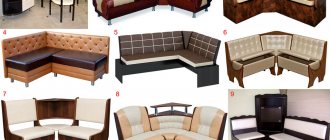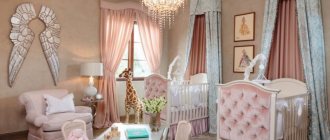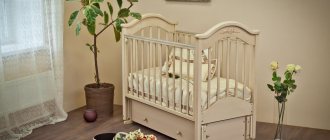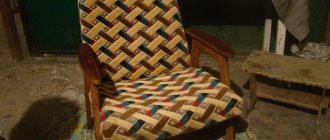Cool corner and its tasks
A properly designed classroom corner has a significant impact on the educational process, reflects the life of the team, and develops a creative spirit among schoolchildren.
The purpose of the classroom corner is:
- provide students with useful and comprehensive information,
- reflect the life of the class,
- broaden the horizons of schoolchildren,
- increase the productivity of the educational process,
- identify and develop children's creative abilities,
- improve work with parents.
For every teacher, designing a classroom corner is an important and responsible task that requires a special approach.
Choosing a design depending on the gender and age of the child
In a corner for a schoolchild, the furniture must correspond to the height and age of the child. A standard table will not be suitable for a first-grader; it will not be able to provide the correct seating position, which will most likely lead to curvature of the spine. For children 7-11 years old, it is recommended to purchase growing models. The height of the tabletop varies, so the child can always sit correctly. The following requirements must be met:
- elbows rest freely on the table;
- the forearms are located slightly below the elbow joints;
- the edge of the tabletop is at chest level;
- The distance from the eyes to the notebook is about 35 cm.
It is better to purchase furniture with your child, so that he can sit at the table and understand how comfortable he is.
For primary school students, it is recommended to choose not a regular table, but a desk with an inclined tabletop. It will ensure the correct development of posture and the formation of handwriting. If it is not possible to purchase a low table that matches your height, you can compensate for the height with an adjustable chair. In this case, a footrest is needed.
A student over 11 years old can already use a standard desk or computer desk. He can choose a full-fledged corner with many shelves, drawers, and racks. It is desirable that most of them are closed. This will provide the teenager with the opportunity to maintain personal space and their secrets.
A schoolchild at this age needs a computer, so there should be enough space on the table for both the equipment itself and for writing. Your teen will also need a computer chair. If it has armrests, this should not prevent you from sliding it under the table.
For a schoolchild's corner, the furniture should correspond to the interests of the child and his gender. Girls choose a design in light, pastel colors. Often the side surfaces of furniture are decorated with carvings and patterns. The table should have many closed drawers for storing small items. If there is no dressing table in a teenage girl’s room, then the opportunity to bring beauty to the school corner will be very useful. For boys, a simpler and more ascetic design is chosen. The following colors are more suitable: blue, light blue, grey, brown, green.
Tips for choosing a corner wardrobe for a nursery, typical furniture dimensions
For children 7-11 years old, purchase growing models
For primary school students, choose a desk with an inclined tabletop
A student over 11 years old can use a standard table
Cool do-it-yourself corner
Of course, now you can purchase a ready-made bright and colorful stand with information materials for a classroom corner. But in this case, it should be possible to replace such materials with your own. After all, monotony will quickly get boring, and monotonous messages are of little use.
The second option is to use templates to decorate the classroom corner. You can also find such templates on the pages of our website, for example here:
- Templates for a unified design of the “New Generation” classroom corner
- Uniform design of a classroom corner in an elementary school
The third option is to make a cool corner with your own hands from start to finish. To create it, you can resort to the help of parents and students. Materials for manufacturing can be used in a variety of ways: from ordinary cardboard to plywood and plastic tiles.
In order for the classroom corner to constantly arouse interest among schoolchildren, during its design it is necessary to consult with them, and when selecting material to place in the classroom corner, their opinion should be taken into account. But the main content of the stand should still be determined by the class teacher, based on personal experience and the characteristics of the class team.
Working together on the design of a stand brings students together and gives them irreplaceable experience in communicating with each other. Working on such an interesting project, children show their creativity, learn to look for interesting, creative solutions and make compromises. It wouldn’t hurt to involve parents in the work, especially if it is necessary to decorate a classroom corner in an elementary school.
The selection of material and topics for the stand differs, depending on for which classes you need to design a classroom corner - senior or elementary. For younger students, colorfully designed play materials are suitable; classroom corners for older grades should contain educational and scientific information necessary to broaden their horizons.
Setting up a schoolchild's corner
The choice of room furnishings is influenced by several factors: the area of the room, the number of schoolchildren, the gender and age of the children. In small rooms, designers suggest installing furniture structures that combine several zones.
Desk
Furniture for schoolchildren at home has a special design. According to the recommendations of experts, the optimal table dimensions are 120x60 cm. Desks can be equipped with mechanisms for adjusting the height of the tabletop and its angle of inclination. Additional elements will not be superfluous: under-desk cabinets, a retractable keyboard panel, shelves for books, notebooks, a monitor stand. Desks can be either elements of a furniture set or independent products.
For younger schoolchildren, it is advisable to choose transformable furniture that can be easily transformed as the child grows. After all, if the student’s desk is low or high, this will have a bad effect on the spine and vision. For comfortable work, the table top can be raised (recommended tilt angle is 15˚). Also, models are often equipped with cabinets on wheels, which can be used as a pouf.
Ergonomic school desk for growth
Multifunctional children's furniture is relevant when arranging a one-room apartment. Such models are compactly located in the corner. Common options: a loft bed and a work area with a table on the lower tier.
Teenage girls will love elegant solid wood tables. Models with open and blind sections and drawers will allow you to store books, notebooks and numerous girlish trinkets.
Boys' work corners will be stylishly complemented by computer desks made of metal frames with glass tops. On the shelves, arranged in the form of add-ons, it will be convenient to lay out writing instruments and books, as well as place a monitor.
Original computer desk with forged base
Armchair chair)
The choice of chair should also be approached responsibly. It is advisable to purchase products in which the seat height is adjustable. When the child is in a sitting position, his thighs and shins should form a right angle, which is possible with the correct chair height.
Models that allow you to adjust the angle of the backrest will help you maintain correct posture. It is believed that a tilt of just over 90˚ is optimal for ensuring correct back position. If the chair has armrests, their height should be adjustable.
A school chair that provides the student with correct posture
Sofa or ottoman
For a child, you want to buy furniture that will last for many years. For a relaxation area in a small room, a sofa or ottoman is often chosen.
The main reason for buying a sofa is its versatility:
- It’s easy to create a full-fledged sleeping place at night; all you need to do is lay down some linens. During the daytime, the student can sit down to read or relax while lying down. Such furniture is also suitable for receiving guests;
- Almost all sofas for a children's room are equipped with built-in drawers, which is very convenient for storing linen;
- The products are very compact. The approximate width of the sofa in the assembled position is 90 cm.
To ensure the correct position of the spine, it is recommended to purchase sofas with orthopedic mattresses. For schoolchildren, products made from elastic monolithic polyurethane foam or with independent spring blocks are suitable.
The ottoman is considered a simplified type of furniture and has some features:
- Select models do not have armrests. The back may be absent or low and rigid;
- The couch has limited functionality. Unlike the sofa, it does not fold out;
- There are usually no drawers for linen in such furniture. In a teenager’s small room, you can put a corner ottoman with a lifting seat mechanism. The internal niche is very spacious and is used for folding bedding or storing things.
Stylish ottoman model for schoolchildren
This is a convenient type of furniture for a small room as it takes up less space than traditional sofas. Low price is another important advantage of the ottoman.
Auxiliary furniture
Additional interior items will help maintain order in the workplace. An excellent option for storing books and notebooks would be hanging shelves above the table. Such products do not reduce the area of the countertop and, to get the necessary thing, you don’t have to get up again.
Convenient open shelves for a student's corner
A bedside table on wheels or even a small bookcase will solve the problem of storing school supplies. Such furniture is convenient because things will not gather dust. It is advisable to place objects within the reach of a child’s hand.
An excellent solution would be to use a shelving unit to highlight the work area. Thanks to the open projections, the room space remains visually free. You can beautifully arrange souvenirs, figurines or photos on the shelves. It is advisable to make the lower shelves closed and use them to store clothes, toys and stationery.
How to design a cool corner
Previously, in the methodological literature one could find recommendations on the correct design of classroom corners, now there are no specific rules and standards, and the class leader can show all his imagination in this direction.
The classroom corner is a kind of visiting card of the class, an indispensable tool in organizing the educational process, therefore its correct design is of great importance.
Aesthetics and neatness are important conditions in the design of a classroom corner. No less important is a creative approach and originality - drawings and photos would be appropriate here, as well as creative ideas from schoolchildren for all kinds of competitions and olympiads. It is necessary to take into account the feasibility of placing certain materials. The theme of the stand should correspond to the age of the children and their interests. The classroom corner should reflect not only academics, but also the extracurricular life of students.
Indispensable in terms of reflecting the abilities and talents of children will be a section for creativity, with the appropriate name - “Our Achievements”, “Creative Piggy Bank”, etc. Placing children's drawings, poems of one's own composition, and applications in this section inspires children and makes them proud of their achievements.
In order for the classroom corner to arouse constant interest among children, the materials must be varied, colorful and useful, and constantly supplemented and changed.
Furniture for a schoolchild: what does the work area consist of?
The very phrase “schoolchildren’s corner” evokes strong associations. The imagination immediately draws a furniture set consisting of a table with a built-in cabinet, two pencil cases with shelves and a hanging open shelf. In general, the idea is correct. If you decide to make a schoolchild’s corner with your own hands, you will definitely need to provide:
- A working area of sufficient length and width. According to accepted ergonomic standards, the width of the table should be about 600mm (500-700 for a complex round shape) and a length of at least 1000mm (usually standard desks are offered with a length of 1200-1300mm across the tabletop). Corner tables are the most convenient and functional.
- A place to store writing and other supplies. Pencils, pens, felt-tip pens, paints, rulers, various educational devices, albums and notebooks used to be most conveniently stored in drawers. But now the market offers many attractive organizers that will allow you to easily arrange all this on open shelves, in special containers, “cases” and boxes, and there is no longer such a need for drawers.
- A place to store large-sized creative kits, crafts, toys and books. Hanging shelves, which can be either open or closed with facades, perfectly cope with this role. You can also include a low pencil case or cabinet in the furniture set for a schoolchild.
Information for the classroom corner
In the corner of the classroom you can place the class logo and its motto, the rules and laws of the team, notices and announcements, schedules of electives and duty schedules. Certificates, diplomas, gratitude, and photographs of school events will be an incentive for new achievements. Congratulations on holidays and birthdays placed on the stand will evoke positive emotions among schoolchildren.
Very often, the school’s charter, telephone numbers of students and parents, as well as the class teacher are placed on the school stand. To inform parents, you can also post test results. It would be a good idea to post a schedule of planned events (trips, excursions) indicating the cost and timing.
In order for students to be able to take a break from lessons during recess and relax a little, you can create an entertainment section where jokes, funny stories, puzzles and rebuses will be posted.
Theme of the classroom corner: “Family of ants”
The cool corner consists of three stands and is a forest clearing where ants are hard at work. Grass, flowers and other necessary decorations can be made from fabric. The tree and the anthill with its inhabitants are made of thick paper or cardboard.
On the central stand of the corner there is a large anthill. Above it you can attach a piece of paper with the inscription “Our friendly team” or “Our class”.
The number of ants should correspond to the total number of students in the class. You can display each student's photo on a corner display and mark the ant girls and boys with pink and blue ribbon respectively.
Also, student photographs can be designed in the form of a tree, the crown of which is formed by photographs with the addition of foliage. Leaves can also be made from paper or fabric. The composition is completed by a powerful trunk, cut out of cardboard or made of paper using appliqué or origami techniques. You can place a schedule of classes and bells under the tree.
On the second side stand you can make a “flower of success” with little tips for students and berries with mushrooms, on which you can place the names of the class attendants, children who do not have sick leave, etc.
In addition, space should be left on the stand to display educational information, birthday greetings, student achievements and recommendations for parents. An excellent incentive for the development of creative abilities will be the presence of a block “Our creativity” or “Creative successes of students.”
In this case, you won’t have to waste your time and do absolutely everything yourself; it will be enough to just choose the right contractor, explain to him all the nuances of the order, then submit an application and, after a set period of time, pick up the completely finished product.
Samples of cool corners (photo of cool corner)
Features of accommodation
It is important to place the study corner correctly. The most important thing is that the light falls from the left for a right-handed person and from the right for a left-handed person, but does not blind the eyes. In addition to artificial lighting, natural lighting is necessary, so the table is placed near the window. It is best to organize a learning space with a corner model. A good option could also be to place furniture in front of the window. The surface of the table can be combined with the window sill, which will save space.
When dividing a room into zones, the first thing you need to do is find the right place to place the table. It should be located near the window. In a large room, you can install a corner table not in a corner, but against the side wall. This way it will separate the work area. If the room is small and the corner is equipped with a pull-out or folding bed, it needs to be removed during the day so that nothing disturbs the child while doing homework.
Purpose of pictures on lockers for kindergarten, requirements for them
When installing the selected furniture corner, you need to consider the following requirements:
- all drawers must have stops;
- hanging elements should be securely fastened;
- wires, sockets, power supplies must be hidden;
- The chair on wheels and extensions must move freely on the floor.
You should not place the study corner in a dark corner or fence it off with cabinets. The place should be well ventilated and spacious.
Corner with a bed: what to do when there is not enough space in the nursery?
Particular attention should be paid to the desk, at the top of which there is a bed. This option will especially appeal to those who want to save space in the room. This is simply a brilliant solution for lack of space. Thus, even in a small room, two children will feel comfortable, since each of them will have their own corner.
Among other things, the children themselves will really like this way out. They will have the opportunity not only to sleep much higher, but also to have their own real fortress, which no one can encroach on. If not all, then many children dream about this.
To summarize, we can say that a school corner in the nursery will help both parents and children enjoy the learning process and participate in it efficiently.
Is it possible to do without a corner in a children's room?
Of course, no one will force parents to place such a set of furniture in the children's room. Many may argue that you can do just fine without it. And indeed it is. You can place it on an ordinary table with an ordinary chair, and store everything you need for studying in a closet or on shelves located on one of the walls of the room.
And yet, one cannot help but pay attention to the advantages that the corner provides for the student. They are definitely worth knowing about. In many ways, they are a good and convincing reason to still purchase a similar product for the nursery. What are these benefits?
- Thanks to the corner, you can save a lot of space due to the fact that the furniture is combined into one set, which takes up very little space;
- You can save money and time by purchasing it; manufacturers try to make this product as affordable as possible, so they care not only about its price, but also about organizing delivery throughout the region;
- A set of furniture will be more likely to be combined with the overall design of the room than individual elements;
- Among other things, it is also very convenient for the child himself, because everything he needs is at his fingertips;
- A schoolchild's corner allows you to easily arrange a proper place for your child to study, which is also of great importance.
In addition, one cannot help but pay attention to the reviews left by satisfied parents about purchased products of this kind. The best advertising is a recommendation from someone who has already tried what they are advertising. Often it is reviews that help parents make the right choice.
Variety of products
Of course, school corners are very, very different. This also characterizes this product well. Diversity allows us to satisfy the needs of many parents and children. Furniture for every color, taste, size, expensive and not so expensive. In short, everyone can choose what they like. For clarity, we can provide some enumeration demonstrating diversity.
- Furniture for boys and girls;
- Corners of large and small sizes;
- Multifunctional and “light”;
- With or without bed;
- Wooden and plastic.
Of course, these are not all the criteria. But they will already be quite enough to confirm that school corners are different.
